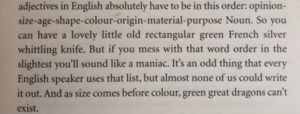
In a post on Killzone, PJ Parrish suggests that understanding the hierarchy of the five senses can help create more logical and therefore immersive sensory descriptions of your setting. “One of my pet peeves is lack of sensory logic in description,” Parrish says. “It means that the writer — who might be seeing a scene unfold with cinematic clarity in their head — does not adhere to basic sequential logic in describing something.”
If you’re still not sure what Parrish means, consider this example. “When you enter someone’s house, what is the first thing you notice?” she asks. “The feng sui alignment of the furniture? The chatter of their chihuahuas? The stink of the morning’s burnt toast? I’d bet on the toast.”
You’ve probably seen the internet meme about logical adjective order: opinion-size-age-shape-colour-origin-material-purpose noun. As Mark Forsyth explains in The Elements of Eloquence: How to Turn the Perfect English Phrase:

According to Parrish, in most cases, the same concept applies to sensory input. “When you enter a scene, don’t go to the default sense of sight,” she suggests. “Take your time and try to walk in your character’s shoes. What are they aware of first?” Often, smell is the most potent and poignant sense. Parrish offers a few tips on sensory logic:
- Don’t rely on sight. When describing your setting, go beyond sight. As an exercise, describe a setting using every sense except sight.
- Filter your sensory description through your character’s prism of experience — not your own. “A child might smell bubble gum whereas an old woman smells Estee Lauder’s Tuberose perfume,” Parrish notes.
- Be original. “Good description is hard writing,” Parrish says. “Don’t settle. Rain has a specific sound and smell, depending on the mood of your scene. Cherry Chapstick changes the taste of a kiss. My dog’s ears feel like worn velveteen.”
Parrish also shares some examples, including a before-and-after contrast of a scene written with and without sensory logic and a scene from one of her books.











